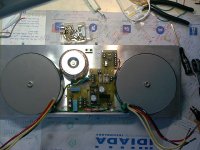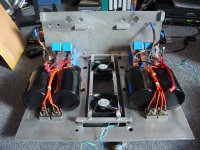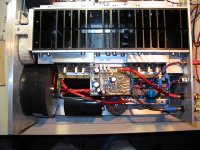Hi Brian,
That could work. It would have to be a small one that runs off house power. That would be good for Europe where there is a lot of small diesels. I don't know is there are small ones available here in the US that runs on 120AC.
Rodd Yamas***a
What about implementing something similar to an engine block heater?
That could work. It would have to be a small one that runs off house power. That would be good for Europe where there is a lot of small diesels. I don't know is there are small ones available here in the US that runs on 120AC.
Rodd Yamas***a
Water cooling (or heating!)
If you used water cooling and a heat exchanger, you could simply heat the water in the reservoir to the required temperature (and cutoff with a thermostatic switch).
If you used water cooling and a heat exchanger, you could simply heat the water in the reservoir to the required temperature (and cutoff with a thermostatic switch).
Leaving amplifiers on "standby"
One of the things you should be aware of is that if you run the amplifier on standby with any significant quiescent current the power supply caps will not last nearly as long as if you'd switched the amplifier off. This could prove quite expensive before too long.....
One of the things you should be aware of is that if you run the amplifier on standby with any significant quiescent current the power supply caps will not last nearly as long as if you'd switched the amplifier off. This could prove quite expensive before too long.....
William,
Please let us know how the aleph sound compares to the ML331. I've never heard any of Nelson's amps whereas i'm vaguely familiar with the 331. Have you done any serious comparisons? They're based on diametrically opposed technologies so a head to head should be really interesting.
regards
peter
Please let us know how the aleph sound compares to the ML331. I've never heard any of Nelson's amps whereas i'm vaguely familiar with the 331. Have you done any serious comparisons? They're based on diametrically opposed technologies so a head to head should be really interesting.
regards
peter
If you really interested, here're some quotes from Stereophile's Muse Kastanovich comparing Aleph3 and ML 333.
"Levison imparted a slight but persistent quality to everything played through it. It was a little metallic, changing instruments timbres and hardening the texture of the whole ensemble. The woodwinds sounded less woody and the solo violins sounded too wispy. In adition to that, the Levinson soundstage was not as large, and the hall reverberation was less audible. Nor was its microdynamics as fast or as natural.
If the No.333 had to be characterized with one phrase, it would be synthesizerlike. It gave a somewhat Technicolor presentation of music, superficially dramatic but missing some of the juicy harmonic body that can be enjoyed from the recording. This is of course, in comparison to the sound of Aleph3. In comparison to other amplifiers, the Levinson may very well sound natural and open; but after becoming accustomed to what the Pass amp could do, I just didn't want to keep listening to the Levinson for very long.
Perhaps the most telling indicator of good overall sound for an experienced listener is their whole emotional response to a familiar recording. Though music was very enjoyable through both the Mark Levinson No.333 and the Quicksilver M-135s, it did not create quite the excitement and happiness that it did when played through the Pass Aleph3. The Aleph3 is juuuuuuuuuuust right!"
The Pass Labs Aleph3 is, by a good margin, the finest power amplifier I have ever had in my system."
Anybody still questioning my decision to modify A75 into Aleph?😉
"Levison imparted a slight but persistent quality to everything played through it. It was a little metallic, changing instruments timbres and hardening the texture of the whole ensemble. The woodwinds sounded less woody and the solo violins sounded too wispy. In adition to that, the Levinson soundstage was not as large, and the hall reverberation was less audible. Nor was its microdynamics as fast or as natural.
If the No.333 had to be characterized with one phrase, it would be synthesizerlike. It gave a somewhat Technicolor presentation of music, superficially dramatic but missing some of the juicy harmonic body that can be enjoyed from the recording. This is of course, in comparison to the sound of Aleph3. In comparison to other amplifiers, the Levinson may very well sound natural and open; but after becoming accustomed to what the Pass amp could do, I just didn't want to keep listening to the Levinson for very long.
Perhaps the most telling indicator of good overall sound for an experienced listener is their whole emotional response to a familiar recording. Though music was very enjoyable through both the Mark Levinson No.333 and the Quicksilver M-135s, it did not create quite the excitement and happiness that it did when played through the Pass Aleph3. The Aleph3 is juuuuuuuuuuust right!"
The Pass Labs Aleph3 is, by a good margin, the finest power amplifier I have ever had in my system."
Anybody still questioning my decision to modify A75 into Aleph?😉
analog_sa,
peter´s post kinda sums it up. I must say though that the 331 was the first ML amp I could listen to a bit longer without getting very tired. Before that I had the 27 and 29 at home (just to listen to) and thought they were too bright with an overdamped bass.
But still nobody has answered my question concerning standby of the input circuit.🙁 Has anybody tried this???? What will happen to the output when I fire up the output stage???
william
peter´s post kinda sums it up. I must say though that the 331 was the first ML amp I could listen to a bit longer without getting very tired. Before that I had the 27 and 29 at home (just to listen to) and thought they were too bright with an overdamped bass.
But still nobody has answered my question concerning standby of the input circuit.🙁 Has anybody tried this???? What will happen to the output when I fire up the output stage???
william
finally (almost) finished
Hi all,
just a pic of the (almost) finished Aleph5. Don´t know how I will finish the case so for now I settle for this "unfinished" look.
Since the last reports I changed the trimmers for R19 and R21 with resistors (49k and 390R) so now it runs at 2.4A bias and about 63% ac current gain (about 6.7A peak).
I will leave it this way and start on a pair of monos with about 31volt rails and 4A bias with 6 paralleled fets. I think this will cure the power problem into 2-3 ohms and make for some happy listening....
william
Hi all,
just a pic of the (almost) finished Aleph5. Don´t know how I will finish the case so for now I settle for this "unfinished" look.
Since the last reports I changed the trimmers for R19 and R21 with resistors (49k and 390R) so now it runs at 2.4A bias and about 63% ac current gain (about 6.7A peak).
I will leave it this way and start on a pair of monos with about 31volt rails and 4A bias with 6 paralleled fets. I think this will cure the power problem into 2-3 ohms and make for some happy listening....
william
Attachments
wuffwaff - I'm designing one chasis at this moment - so I'm interested how didi you done the front panel?? Is the centre part screwed from the back or what?? How thick is material??
Hi William,
Looks very nice and stylish. Maybe if you get a chance, you could post more pics of the inside of the amp.🙂
Thanks,
Rodd Yamashita
Looks very nice and stylish. Maybe if you get a chance, you could post more pics of the inside of the amp.🙂
Thanks,
Rodd Yamashita
Stabist,
yes, the middle part is screwed from the back. Both this and the front panel are 10mm thick.
Rodd,
will post some more pictures but at the moment I'm in Spain (and my computer is not...) for about two weeks.
william
yes, the middle part is screwed from the back. Both this and the front panel are 10mm thick.
Rodd,
will post some more pictures but at the moment I'm in Spain (and my computer is not...) for about two weeks.
william
Hi Wuffwaff,
Congratulations to your great looking amp.
We talked about the crescendo´s before if you remember.
I´m almost finished with it and wanna probably build an aleph too. How do both of them compare soundwise?
Where do you get your aluminium?
If been looking for good/cheap sources in germany who deliver small quantities but haven´t found anything so far.
thanks in anticipation
greetings
Jens
Congratulations to your great looking amp.
We talked about the crescendo´s before if you remember.
I´m almost finished with it and wanna probably build an aleph too. How do both of them compare soundwise?
Where do you get your aluminium?
If been looking for good/cheap sources in germany who deliver small quantities but haven´t found anything so far.
thanks in anticipation
greetings
Jens
Hello Jens,
yes I do remember (and last week I even found the pictures I was looking for).
Getting aluminium is rather difficult. The 4mm I used for the case was rel. easy to find at a construction shop near me. The 10mm is still some old supply I got at university (3euro for a kilo). I'm trying to get some new 10mm aluminium at the moment but this will probably come from some dark sources............
Concerning Aleph against my Crescendo is rather difficult and depends on the speakers your using. In (very) short:
The Aleph gives a bit more detail and deeper bass, the cresendo gives more middbass (80-120Hz) and sound a bit more dynamic. I also find the Aleph giving me more natural sound on acoustic instruments and a more solid and precise soundstage. So in this case it also depends on the sort of music your listening to wich amp sounds better.
I hope that with building some monos withb greater current capability I will get the best of both worlds.
william
yes I do remember (and last week I even found the pictures I was looking for).
Getting aluminium is rather difficult. The 4mm I used for the case was rel. easy to find at a construction shop near me. The 10mm is still some old supply I got at university (3euro for a kilo). I'm trying to get some new 10mm aluminium at the moment but this will probably come from some dark sources............
Concerning Aleph against my Crescendo is rather difficult and depends on the speakers your using. In (very) short:
The Aleph gives a bit more detail and deeper bass, the cresendo gives more middbass (80-120Hz) and sound a bit more dynamic. I also find the Aleph giving me more natural sound on acoustic instruments and a more solid and precise soundstage. So in this case it also depends on the sort of music your listening to wich amp sounds better.
I hope that with building some monos withb greater current capability I will get the best of both worlds.
william
wuffwaff said:
But still nobody has answered my question concerning standby of the input circuit.🙁 Has anybody tried this???? What will happen to the output when I fire up the output stage???
Assuming that the main rails are shut off during stand-by,
nothing will happen as long as your matching is good.
At the same time, if the main rails, particularly the negative
rail, is off during stand-by, then there is no value to having
the diff pair on all the time, as they will not dissipate enough
energy to hold the temperature.
Bias measurements
Hello,
This may seem a kind of dumb question, but I'm new to this stuff. When you say 11 amps of bias, what exactly are you measuring? Is it just the idle current draw?
Cheers,
Greg.
Hello,
This may seem a kind of dumb question, but I'm new to this stuff. When you say 11 amps of bias, what exactly are you measuring? Is it just the idle current draw?
Cheers,
Greg.
Hi Greg,
Yes, (well maybe not 11A), the bias current circulates from the power supply, through the output devices and back to the power supply when the amp is idling at zero output.
Rodd Yamashita
Yes, (well maybe not 11A), the bias current circulates from the power supply, through the output devices and back to the power supply when the amp is idling at zero output.
Rodd Yamashita
Greg,
to measure the bias current you measure the voltage over the source resistors (3,6 or 12) and devide this by the value of the source resistors. So you get the current through these. Add them and you have the total bias current.
(This normally is a bit lower than 11A........)
william
to measure the bias current you measure the voltage over the source resistors (3,6 or 12) and devide this by the value of the source resistors. So you get the current through these. Add them and you have the total bias current.
(This normally is a bit lower than 11A........)
william
more pictures
Hi all,
I´m back home again so now I can post some more pictures.
This ones shows the front, seen from the back with the two transformers (600VA, 2x25V), the soft start and the 12V supply with the fuses for the three transformers. The on/off switch is at the bottom.
Hi all,
I´m back home again so now I can post some more pictures.
This ones shows the front, seen from the back with the two transformers (600VA, 2x25V), the soft start and the 12V supply with the fuses for the three transformers. The on/off switch is at the bottom.
Attachments
- Home
- Amplifiers
- Pass Labs
- Aleph5....it works!!!



